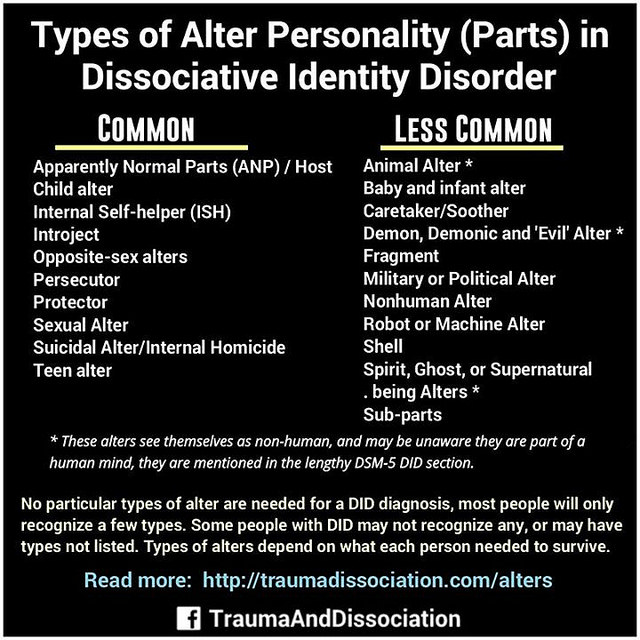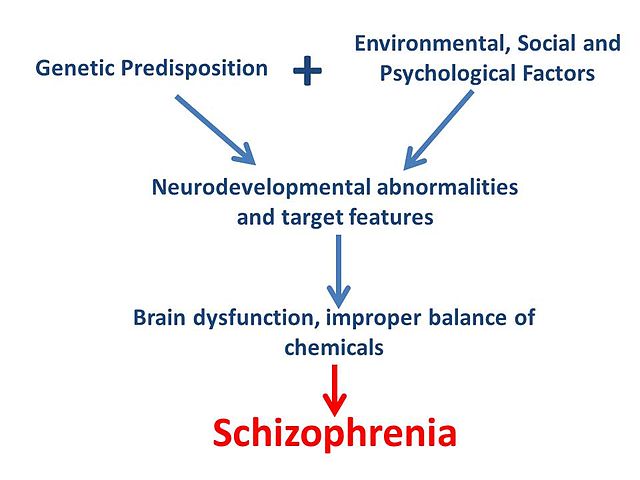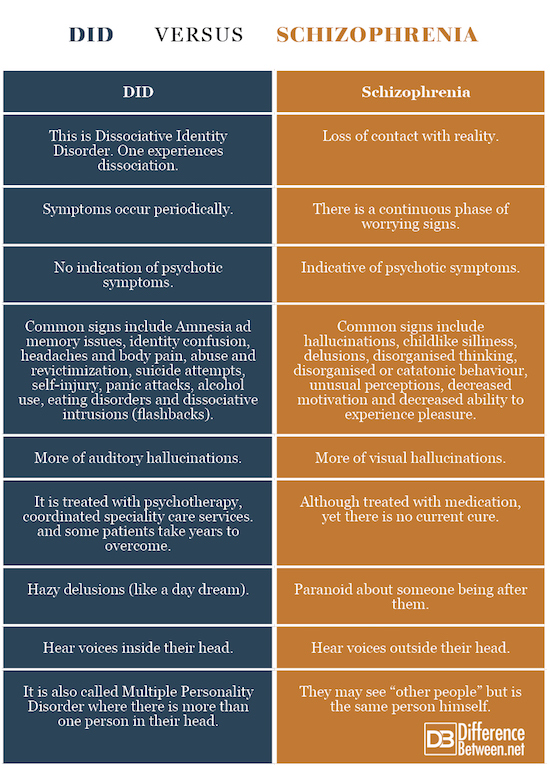Difference Between Dissociative Identity Disorder (DID) and Schizophrenia
Schizophrenia and DID are often misunderstood and thought to be similar kinds of mental illness, but they are actually very different.
Schizophrenia usually happens when a mother is exposed to some viruses or malnutrition at the time of 1st or 2nd trimester of pregnancy. It also involves alteration of brain activity that includes the neurotransmitters dopamine and glutamate.
Dissociative disorders (DID), usually happens as a result of any traumatic event. The traumatic event could be physical abuse, any aggressive combat mission, reminiscence of which the brain attempts to control. The illness becomes worse when an individual is under tremendous stress.
What is Dissociative Identity Disorder (DID)?
DID (previously known as multiple personality disorder) is a complicated psychological condition that is triggered by many reasons like severe trauma during early childhood (for e.g. extreme physical abuse or extreme emotional abuse). The disorder can last for years, become chronic and in some cases, last lifelong. Treatment involves supportive care, counselling and talk therapy. Frequency is ~2% of people.
What is Schizophrenia?
Schizophrenia is a mental disorder characterised by thoughts or experiences which are nowhere close to real world. It includes erratic speech or behaviour and reduced participation in daily activities. Issues associated with concentration and memory can also be seen. What triggers this disorder is not known, however, scientists claim that a combination of genetics, external environment and altered brain mechanism and structure could be responsible. About 1% of all people develop schizophrenia.
Difference between DID and Schizophrenia
Definition
DID
The full form is Dissociative Identity Disorder and is also known as Multiple Personality disorder. The disorder is a response to any traumatic event as a way to help an individual avoid any displeasing memories. The mental disorder is characterized by tow or more distinct split identities, personality states
Schizophrenia
Schizophrenia is a mental disease that usually appears in late adolescence or in early adulthood. The exact cause of this disorder is not known. Some individuals are prone to this mental disorder and extreme and emotional life event might lead to a psychotic event.
Schneiderian Symptoms and Delusions
These are usually present in both DID and Schizophrenia. However, there are differences in delusions in both cases.
DID
The delusions in this case are “delusions of many personalities” or of other outside changes that are representative of the several personalities (like the changes in walking style, standing posture, audio, face expressions etc.).
Schizophrenia
In this case, the delusions are bizarre, extreme anxiety delusions, or some other delusions which have nothing to do with other personalities. For e.g. “someone is out and after to get me”.
Types
DID
There are 3 types:
- Dissociative identity disorder.
- Dissociative amnesia.
- Depersonalization/derealization disorder.
Schizophrenia
Types include:
- Paranoid Schizophrenia
- Disorganized Schizophrenia
- Catatonic Schizophrenia
- Schizoaffective Disorder
- Undifferentiated Schizophrenia.
- Residual Schizophrenia
Symptoms
DID
Symptoms of DID include:
- Amnesia (deficit in memory which happens by brain injury, disease, or psychological trauma)
- Blackouts, of certain time intervals, events, individuals and personal information
- Hearing one or more talking voices (hallucinations that include perceiving sounds without auditory stimulus).
- Impulsivity.
- Self -destruction behaviour or mutilation.
- Inability to cope up with personal and professional stress
- Blurred sense of identity
- Inability to trust others
- Feeling cheated and betrayed by others
- Suicidal thoughts and behaviours
- The affected individual referring to himself or herself as “we”
- Sleep issues, including nightmares, automatic writing (such as those in fugue states), insomnia and sleepwalking.
- Increased level of sexual dysfunction
- Certain phobias and fear
- Delinquency
- Sense of guilt and shame
- Erratic approach to gaining knowledge and skills
- Alcoholism
Schizophrenia
Symptoms include:
- Social isolation
- Deterioration of personal hygiene
- Insomnia, forgetful, unable to focus
- Irrational, angry or fearful response to loved ones
- Extreme preoccupation with religion or the occult
- Lack of motivation (avolition)
- Blunted emotions.
- Reduced social engagement and emotional expression
- Visual hallucinations, and disorganized thoughts
- Grossly disorganized or catatonic behaviour
- Alogia – A poverty of speech, for e.g. brief, empty replies, rapid and frenzied speaking, or speech disorder.
- Avolition – Unable to initiate and persist in objective-directed activities (for e.g. school or work).
- Impaired motor coordination
- Compulsive behaviour
- Reckless pursuit of gratification
- Hostility and self-harm
- excitability, repetitive movements, and absence of restraint
Psychotic Symptoms
DID
Psychotic symptoms in DID are absent.
Schizophrenia
psychotic symptoms in this disorder include: thinking that exhibits, catatonic behaviour and no emotions at all (chronic flat affect).
Identity Confusion/disturbance
DID
With DID, the changes in identity are consistent and recurrent.
Schizophrenia
someone suffering from Schizophrenia have identity issues and are unable to understand their role in society.
Reality Testing
DID
DID patients have intact reality testing.
Schizophrenia
Individuals with this disorder have impaired reality testing.
Comorbid Diagnoses
DID
Manic syndrome may exist alongwith the dissociative syndrome.
Schizophrenia
In Schizophrenia, mood episodes are brief in comparison to how long active and residual stages last.
Summary of difference between DID and Schizophrenia
The points of difference between DID and Schizophrenia have been summarized in a chart format below:
DID Vs. Schizophrenia
- Difference Between Global Warming and Greenhouse Effect - May 18, 2024
- Difference Between Vaccination and Immunization - March 3, 2024
- Difference Between Selective Mutism and Autism - February 25, 2024
Search DifferenceBetween.net :
Leave a Response
References :
[0]Gillig, P. M. (2009). Dissociative identity disorder: A controversial diagnosis. Psychiatry (Edgmont), 6(3), 24.
[1]Sullivan, P. F. (2005). The genetics of schizophrenia. PLoS medicine, 2(7), e212.
[2]Image credit: https://upload.wikimedia.org/wikipedia/commons/thumb/f/f6/Schizophrenia_flowchart.jpg/640px-Schizophrenia_flowchart.jpg
[3]Image credit: https://www.flickr.com/photos/traumaanddissociation/26179791100



